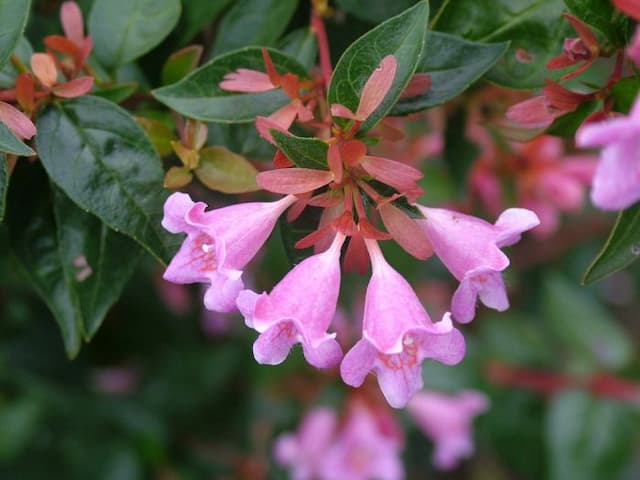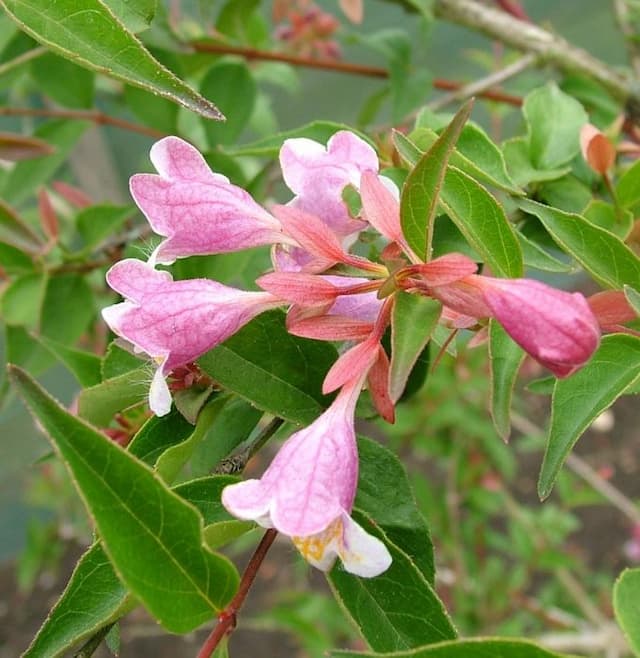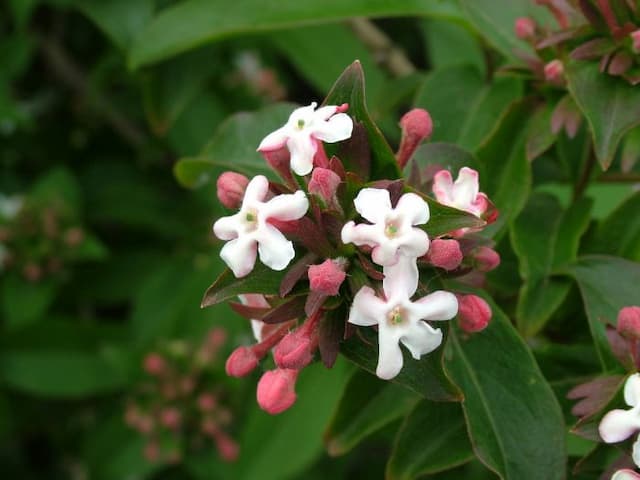Coralberry Symphoricarpos orbiculatus

ABOUT
The plant commonly known as Coralberry is a decident shrub with an intricate branching pattern. Its stems are slender and arching, contributing to a dense, bushy appearance. This shrub bears simple, opposite leaves that are oval-shaped with a slightly heart-shaped base, presenting a smooth margin. The foliage is known to have a dull green hue that transitions to a yellowish color or may remain unchanged in the fall. Coralberry is appreciated for its charming small pinkish to purplish flowers that bloom along its branches in the summer. These blooms are bell-shaped, often growing in clusters, and attract pollinators like bees and butterflies. When the flowering season concludes, the plant produces the berries it is most famous for. These berries are usually a glossy, deep magenta or purple color, which stands out against the foliage. These vibrant berries are not only a visual treat but also serve as an essential food source for birds and wildlife during the colder months when food is scarce. The berries typically persist throughout the winter, providing a splash of color against the bleak landscape. The unique combination of its leafy green backdrop and the bright berries makes the Coralberry a picturesque addition to any garden setting where it's known to spread and may form thickets without concern for the plant's specific dimensions.
About this plant
 Names
NamesFamily
Caprifoliaceae.
Synonyms
Coralberry, Indiancurrant, Buckbrush, Wolfberry, Indian Currant, Coral Berry.
Common names
Symphoricarpos microphyllus, Symphoricarpos orbiculatus var. microphyllus, Symphoricarpos symphoricarpos, Symphoricarpos vulgaris.
 Toxicity
ToxicityTo humans
The most common common name for Symphoricarpos orbiculatus is coralberry. Coralberry is considered to have a low level of toxicity for humans. If ingested, it might cause mild symptoms such as vomiting or diarrhea. It is generally recommended to avoid eating any part of this plant to prevent these unpleasant gastrointestinal reactions.
To pets
For pets, especially dogs and cats, coralberry can also be mildly toxic. If a pet ingests part of this plant, they might experience symptoms like vomiting, diarrhea, and general gastrointestinal upset. It's advisable to keep this plant out of reach of pets to avoid these potential health issues.
 Characteristics
CharacteristicsLife cycle
Perennials
Foliage type
Deciduous
Color of leaves
Green
Flower color
Pink
Height
3-5 feet (0.9-1.5 meters)
Spread
4-6 feet (1.2-1.8 meters)
Plant type
Shrub
Hardiness zones
4-7
Native area
North America
Benefits
 General Benefits
General Benefits- Wildlife Support: The fruits of Symphoricarpos orbiculatus, commonly known as coralberry, provide food for birds and small mammals during winter when other food sources are scarce.
- Erosion Control: Coralberry can be used for stabilizing soils and controlling erosion due to its dense, spreading growth habit.
- Low Maintenance: Coralberry is a hardy plant that requires minimal care once established, making it ideal for low-maintenance landscaping.
- Drought Tolerance: The plant is tolerant of drought conditions, which is beneficial in areas susceptible to water shortages or restrictions.
- Aesthetic Appeal: Coralberry’s pinkish-red berries add visual interest to gardens and landscapes, especially in the fall and winter months when color is often lacking.
- Habitat Restoration: Native to North America, coralberry can be used in restoration projects to help re-establish natural plant communities.
- Shade Tolerance: This plant can grow in shaded areas where other plants might struggle, which is useful for underplanting in wooded gardens or forest edges.
- Winter Interest: Coralberry maintains its structure and berries into the winter, providing a decorative aspect to gardens during the colder months.
 Medical Properties
Medical PropertiesThis plant is not used for medical purposes.
 Air-purifying Qualities
Air-purifying QualitiesThis plant is not specifically known for air purifying qualities.
 Other Uses
Other Uses- Symphoricarpos orbiculatus, also known as coralberry, is sometimes used in landscaping as a ground cover due to its tolerance of shade and ability to form dense thickets.
- Coralberry can be planted for erosion control because its dense root system helps to stabilize soil on slopes.
- The plant serves as a food source for wildlife; birds commonly eat the berries in winter when other food sources are scarce.
- Coralberry is used in winter decorations and wreaths because the berries add a splash of color to arrangements.
- This plant is sometimes used in butterfly gardens as it provides nectar for various species of butterflies and other pollinators.
- Due to its dense foliage, coralberry can be utilized for creating low natural hedges or borders in garden design.
- The colorful berries are used in dried flower arrangements and crafts, retaining their color well after drying.
- Natural dyers sometimes use coralberry to extract a natural dye for fabrics, although the colorfastness and the range of hues are variable.
- The woody stems of coralberry can be fashioned into small handcrafted items or tools, which are primarily decorative.
- Gardeners may use coralberry in permaculture designs as a companion plant that can support beneficial insects and increase biodiversity.
Interesting Facts
 Feng Shui
Feng ShuiThe Coralberry is not used in Feng Shui practice.
 Zodiac Sign Compitability
Zodiac Sign CompitabilityThe Coralberry is not used in astrology practice.
 Plant Symbolism
Plant Symbolism- Protection: Symphoricarpos orbiculatus, commonly known as Coralberry, has been used in Native American traditions to create protective hedges, symbolizing safeguarding and shelter.
- Forgiveness: The Coralberry’s capacity to thrive in harsh conditions can symbolize forgiveness, illustrating the ability to overcome past adversity.
- Healing: Coralberry has medicinal properties, and thus it is often associated with healing both in a physical and spiritual sense.
 Water
WaterCoralberry, the common name for Symphoricarpos orbiculatus, requires moderate watering. During the growing season in spring and summer, water the plant thoroughly once a week with approximately 1-2 gallons, depending on the size of the plant and the environmental conditions. Make sure the top inch of soil is dry before watering again to prevent overwatering. During the fall and winter, reduce the frequency to once every two weeks, adjusting for rainfall and changes in temperature that may affect the soil's moisture level.
 Light
LightCoralberry thrives in a variety of light conditions, from full sun to partial shade. The best spot for this plant is one where it can receive at least four to six hours of direct sunlight per day. However, it's adaptable and can also do well in spots with dappled sunlight or light shade, making it versatile in different garden settings.
 Temperature
TemperatureCoralberry is quite hardy and can withstand a wide range of temperatures. It can survive minimum temperatures down into the -20 degrees Fahrenheit range. Ideally, it prefers temperatures between 60 and 75 degrees Fahrenheit, but it is resilient and can tolerate temperatures well above this range during the hot summer months.
 Pruning
PruningFor coralberry, pruning is done to maintain shape and encourage bushier growth. It's best to prune in late winter or early spring before new growth begins. Cut back the previous year's growth by about a third to promote new shoots and flowers. Pruning can be done every year or every other year, depending on the desired size and shape of the shrub.
 Cleaning
CleaningNot needed
 Soil
SoilCoralberry prefers well-drained soil with a pH of 6.0 to 7.5. A mix containing loam, peat, and perlite in equal parts can support healthy growth. Mulching helps retain moisture and warmth.
 Repotting
RepottingCoralberry shrubs typically do not require frequent repotting if planted in the ground. If grown in containers, repot every 2-3 years or when root-bound for optimal health.
 Humidity & Misting
Humidity & MistingCoralberry does well in average humidity levels typical of outdoor environments and doesn't require special humidity considerations.
 Suitable locations
Suitable locationsIndoor
Place Coralberry in bright, indirect light and water moderately.
Outdoor
Plant Coralberry in partial shade; water regularly.
Hardiness zone
4-7 USDA
 Life cycle
Life cycleThe life cycle of Coralberry (Symphoricarpos orbiculatus) begins with seed germination, which occurs after stratification, a process where seeds must be exposed to cold temperatures before they can sprout. The seedlings then establish themselves and grow into juvenile plants, developing a root system and foliage. As the coralberry reaches maturity, it forms woody stems and begins to produce its characteristic pink flowers during the summer months. After pollination, typically by insects, the flowers give way to the coral-red berries that persist into winter, providing food for wildlife. The plant may also spread vegetatively through sucker growth from its roots. Finally, as part of its perennial growth habit, coralberry will go into dormancy during the winter, losing its leaves and conserving resources until the conditions are suitable for the next growth cycle in the spring.
 Propogation
PropogationPropogation time
Early spring
The Coralberry (Symphoricarpos orbiculatus) is most commonly propagated by hardwood cuttings. This procedure is best undertaken in the late fall to early winter when the plant is dormant. To propagate through hardwood cuttings, one should cut a piece of the stem that is around 6 to 8 inches (15 to 20 centimeters) long and has at least a couple of nodes. The cutting should then be planted in a mixture of half peat and half perlite or in a well-draining soil mixture. It is important to make sure that at least one node is buried underground as this is where the roots will develop. The medium should be kept moist but not waterlogged, and the cuttings should be placed in a bright area without direct sunlight. Roots typically develop within a few weeks, after which the new coralberry plants can be transplanted to their permanent locations.







![Himalayan honeysuckle [Golden Lanterns]](/_next/image?url=https%3A%2F%2Fplants-admin.emdemapps.com%2Fimages%2Fplants%2F%2Fimages%2F604b55302cc87.png&w=640&q=75)

